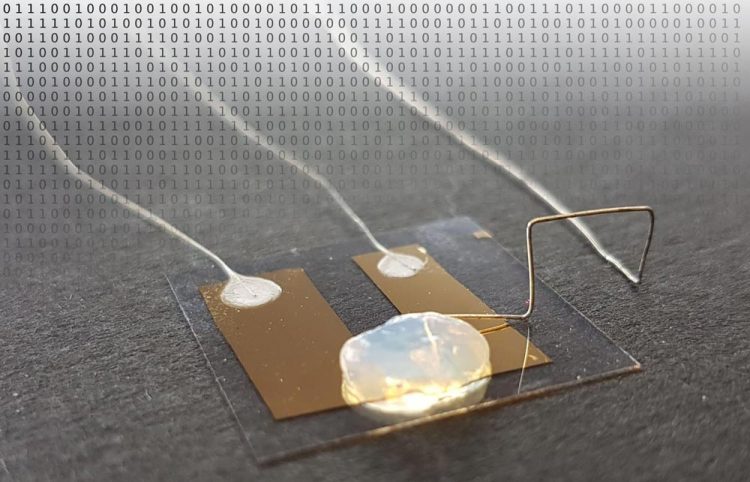Smallest transistor worldwide switches current with a single atom in solid electrolyte

The single-atom transistor that works in a gel electrolyte reaches the limit of miniaturization. Credit: Group of Professor Thomas Schimmel/KIT
At Karlsruhe Institute of Technology (KIT), physicist Professor Thomas Schimmel and his team have developed a single-atom transistor, the smallest transistor worldwide. This quantum electronics component switches electrical current by controlled repositioning of a single atom, now also in the solid state in a gel electrolyte.
The single-atom transistor works at room temperature and consumes very little energy, which opens up entirely new perspectives for information technology. The transistor is presented in Advanced Materials (DOI: 10.1002/adma.201801225).
Digitization results in a high energy consumption. In industrialized countries, information technology presently has a share of more than 10% in total power consumption. The transistor is the central element of digital data processing in computing centers, PCs, smartphones, or in embedded systems for many applications from the washing machine to the airplane. A commercially available low-cost USB memory stick already contains several billion transistors.
In future, the single-atom transistor developed by Professor Thomas Schimmel and his team at the Institute of Applied Physics (APH) of KIT might considerably enhance energy efficiency in information technology.
“This quantum electronics element enables switching energies smaller than those of conventional silicon technologies by a factor of 10,000,” says physicist and nanotechnology expert Schimmel, who conducts research at the APH, the Institute of Nanotechnology (INT), and the Material Research Center for Energy Systems (MZE) of KIT. Earlier this year, Professor Schimmel, who is considered the pioneer of single-atom electronics, was appointed Co-Director of the Center for Single-Atom Electronics and Photonics established jointly by KIT and ETH Zurich.
In Advanced Materials, the KIT researchers present the transistor that reaches the limits of miniaturization. The scientists produced two minute metallic contacts. Between them, there is a gap as wide as a single metal atom. “By an electric control pulse, we position a single silver atom into this gap and close the circuit,” Professor Thomas Schimmel explains.
“When the silver atom is removed again, the circuit is interrupted.” The world's smallest transistor switches current through the controlled reversible movement of a single atom. Contrary to conventional quantum electronics components, the single-atom transistor does not only work at extremely low temperatures near absolute zero, i.e. -273°C, but already at room temperature. This is a big advantage for future applications.
The single-atom transistor is based on an entirely new technical approach. The transistor exclusively consists of metal, no semiconductors are used. This results in extremely low electric voltages and, hence, an extremely low energy consumption. So far, KIT's single-atom transistor has applied a liquid electrolyte.
Now, Thomas Schimmel and his team have designed a transistor that works in a solid electrolyte. The gel electrolyte produced by gelling an aqueous silver electrolyte with pyrogenic silicon dioxide combines the advantages of a solid with the electrochemical properties of a liquid. In this way, both safety and handling of the single-atom transistor are improved.
###
More information: http://aph-ags.
Original Publication:
Fangqing Xie, Andreas Peukert, Thorsten Bender, Christian Obermair, Florian Wertz, Philipp Schmieder, and Thomas Schimmel: Quasi-Solid-State Single-Atom Transistors. Advanced Materials. Adv. Mater. 2018, 30, 1801225. DOI: 10.1002/adma.201801225
Abstract online at https:/
Press contact:
Dr. Joachim Hoffmann, Chief Editor, Phone: +49 721 608-21151, Email: joachim.hoffmann@kit.edu
Being „The Research University in the Helmholtz Association”, KIT creates and imparts knowledge for the society and the environment. It is the objective to make significant contributions to the global challenges in the fields of energy, mobility and information. For this, about 9,300 employees cooperate in a broad range of disciplines in natural sciences, engineering sciences, economics, and the humanities and social sciences. KIT prepares its 25,500 students for responsible tasks in society, industry, and science by offering research-based study programs. Innovation efforts at KIT build a bridge between important scientific findings and their application for the benefit of society, economic prosperity, and the preservation of our natural basis of life.
Media Contact
More Information:
http://dx.doi.org/10.1002/adma.201801225All latest news from the category: Physics and Astronomy
This area deals with the fundamental laws and building blocks of nature and how they interact, the properties and the behavior of matter, and research into space and time and their structures.
innovations-report provides in-depth reports and articles on subjects such as astrophysics, laser technologies, nuclear, quantum, particle and solid-state physics, nanotechnologies, planetary research and findings (Mars, Venus) and developments related to the Hubble Telescope.
Newest articles

A ‘language’ for ML models to predict nanopore properties
A large number of 2D materials like graphene can have nanopores – small holes formed by missing atoms through which foreign substances can pass. The properties of these nanopores dictate many…

Clinically validated, wearable ultrasound patch
… for continuous blood pressure monitoring. A team of researchers at the University of California San Diego has developed a new and improved wearable ultrasound patch for continuous and noninvasive…

A new puzzle piece for string theory research
Dr. Ksenia Fedosova from the Cluster of Excellence Mathematics Münster, along with an international research team, has proven a conjecture in string theory that physicists had proposed regarding certain equations….



